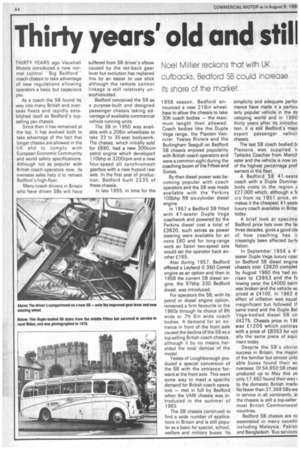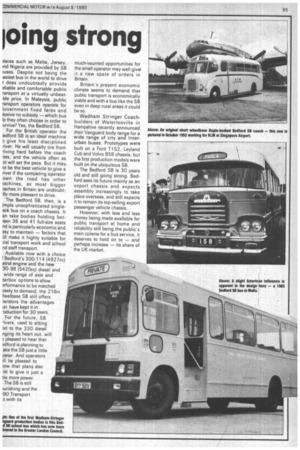Thirty years old and still ping strong
Page 66

Page 67

If you've noticed an error in this article please click here to report it so we can fix it.
THIRTY YEARS ago Vauxhall Motors introduced a new normal control ''Big Bedford" coach chassis to take advantage of new regulations allowing operators a basic but capacious psv.
As a coach the SB found its way into many British and overseas fleets and rapidly established itself as Bedford's topselling psv chassis.
Since then it has remained at the top. It has evolved both to take advantage of the fact that longer chassis are allowed in the UK and to comply with European Economic Community. and world safety specifications. Although not as popular with British coach operators now, its overseas sales help it to remain Bedford's high-flyer.
Many coach drivers in Britain who have driven SBs will have suffered from SB driver's elbow caused by the set-back gear lever but evolution has replaced this by an easier to use stick although the remote control linkage is still relatively unsophisticated.
Bedford conceived the SB as a purpose-built and designed passenger chassis taking advantage of available commercial vehicle running units.
The SB in 1950 was available with a 206in wheelbase to take 33 to 35-seat bodywork. The chassis, which initially sold for £690, had a new 300cuin petrol engine which developed 110bhp at 3200rpm and a new four-speed all synchromesh gearbox with a new hypoid rear axle. In the first year of production, Bedford built 2235 of these chassis.
In late 1955, in time for the 1956 season, Bedford an nounced a new 216in wheelbase to allow the chassis to take 30ft coach bodies — the maxi mum length then allowed. Coach bodies like the Duple Vega range, the Plaxton Ven turer. Yeates Riviera and the Burlingham Seagull on Bedford SB chassis enjoyed popularity with British coach operators and were a common sight during the coaching boom of the Fifties and Sixties.
By then diesel power was becoming popular with coach operators and the SB was made available with the Perkins 108bhp R6 six-cylinder diesel engine.
In 1957 a Bedford SB fitted with 41-seater Duple Vega coachwork and powered by the Perkins diesel cost a total of £3620, such extras as power steering were available for an extra £60 and for long-range work an Eaton two-speed axle would set the operator back another £185.
Also during 1957, Bedford offered a Leyland 0.350 Comet engine as an option and then in 1 958 the current SB diesel engine, the 97bhp 330 Bedford diesel, was introduced.
For operators the SB, with its petrol or diesel engine option, remained a firm favourite in the 1960s through its choice of 8ft wide or 7ft 6in wide coach bodies. A demand for an entrance in front of the front axle caused the decline of the SB as a top-selling British coach chassis, although it by no means heralded the total demise of the model.
Yeates of Loughborough produced a special conversion of the SB with the entrance forward at the front axle. This went some way to meet a specific demand for British coach operators — met in full by Bedford when the VAM chassis was introduced in the summer of 1965.
The SB chassis continued to find a wide number of applications in Britain and is still popular as a basic for special, school, welfare and military buses. Its simplicity and adequate perfor mance have made it a partici.' larly popular vehicle in the de veloping world and in 1980 thirty years after its introduc tion, it is still Bedford's majo export passenger vehicf chassis.
The last SB coach bodied b Plaxtons was supplied tl Tatlocks Coaches from Manch ester and the vehicle is now on of the highest percentage prof earners in the fleet.
A Bedford SB 41-seate coach with a Duple Dominar body costs in the region c £27,000 which, although a f2 cry from its 1951 price, sti makes it the cheapest 41-seat( luxury coach available in Britai today.
A brief look at specime Bedford price lists over the la; three decades, gives a good ide of how coaching has ir creasingly been affected by flation.
In September 1956 a 4' seater Duple Vega luxury coac on Bedford SB diesel engine chassis cost £3620 complet by August 1960 this had on risen to £3953 and the fc lowing yerar the £4000 barri, was broken and the vehicle wE priced at £4100. In 1963 tf effect of inflation was equal insignificant but followed t1 same trend and the Duple Bel Vega-bodied diesel SB co £4275. Chassis price in 19f was £1205 which contras with a price of £8353 for virt ally the same piece of equi ment today.
Despite the SB's obviot success in Britain, the majori of the familiar but almost unlo able buses found their WE overseas. Of 54,850 SB chasE produced up to May this ye only 17,482 found their way ( to the domestic British markE No fewer than 37,368 SBs we in service in all continents, at the chassis is still a top-seller most British Commonweal countries.
Bedford SB chassis are nc assembled in many countri including Malaysia, Pakist and Bangladesh. Bus services daces such as Malta. Jersey, Ind Nigeria are provided by SB ,uses. Despite not being the iasiest bus in the world to drive t does undoubtedly provide eliable and comfortable public ransport at a virtually unbeatble price. In Malaysia, public ransport operators operate for ;overnment fixed fares and eceive no subsidy — which bus Io they often choose in order to urvive? Yes, the Bedford SB.
For the British operator the iedford SB is an ideal machine 3 give his least disciplined
river. He will usually tire from riving hard before the coach oes, and the vehicle often as ot will set the pace. But it may.
ot be the best vehicle to give a river if the competing operator own the road has other iachines, as most bigger aaches in Britain are undoubt-: Jly more pleasant to drive.
The Bedford SB, then, is a imple unsophisticated singleeck bus on a coach chassis. It an take bodies holding betPeen 36 and 41 full-size seats nd is particularly economic and asy to maintain — factors that :ill make it highly suitable for iral transport work and school nd staff transport.
Available now with a choice I Bedford's 300-114 (4927cc) etrol engine and the new 30-98 (5420cc) diesel and wide range of axle and aarbox options to allow arformance to be matched osely to demand, the 216in heelbase SB still offers aerators the advantages at have kept it in
.oduction for 30 years.
For the future, SB -ivers, used to sitting ;xt to the 330 diesel nging its heart out, will a pleased to hear that adford is planning to ake the SB just a little iieter. And operators ill be pleased to low that plans also ist to give it just a tle more power.
The SB is still iurishing and the 180 Transport
:t with its much-vaunted opportunities for the small operator may well givel it a new spate of orders in Britain.
Britain's present economic climate seems to demand that public transport is economically viable and with a bus like the SB even in deep rural areas it could be so.
Wadham Stringer Coachbuilders of Wateriooville in Hampshire recently announced their Vanguard body range for a wide range of city and Interurban buses. Prototypes were built on a Ford T152, Leyland Cub and Volvo B58 chassis, but the first production models were built on the ubiquitous SB.
The Bedford SB is 30 years old and still going strong. Bedford sees its future mainly as an export chassis and expects assembly increasingly to take place overseas, and still expects it to remain its top-selling export passenger vehicle chassis.
However, with less and less money being made available for public transport at home and reliability still being the public's main criteria for a bus service, it deserves to hold on to — and perhaps increase — its share of the UK market.












































































































